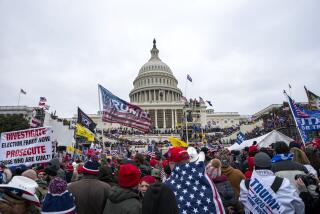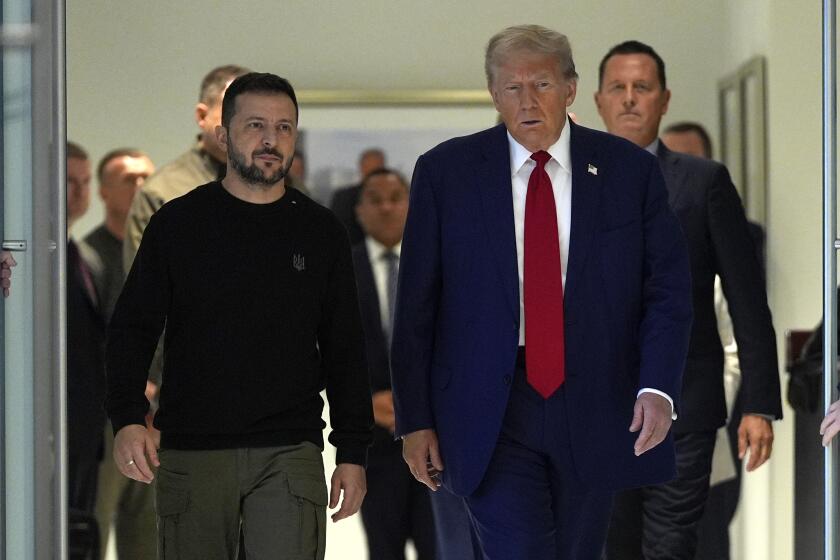As Ferguson braces for grand jury ruling, activists cite ‘fear campaign’
Reporting from Ferguson, Mo. — Missouri officials have repeatedly warned that events after the grand jury decides whether to charge a white Ferguson police officer who fatally shot an unarmed black man will be a balancing act between the need for security and the desire to protect free speech. On Tuesday, officials tried to have it both ways.
Even as this region awoke to a state of emergency and the eventual deployment of local police and the National Guard, some African Americans activists were insisting the city was not going to be destroyed after the long-awaited decision. The grand jury is considering whether to indict Officer Darren Wilson, who shot Michael Brown, 18, on Aug. 9.
“They got the wrong ones if they are worried about the protesters,” said Rasheen Aldridge, 20, a demonstrator from St. Louis who was named as one of the members of the governor’s Ferguson Commission, charged with examining issues of inequality and community divisions raised after the shooting. The 16-member commission was sworn in Tuesday by Gov. Jay Nixon, who declared a state of emergency Monday.
If Wilson is not indicted by the grand jury, “I don’t think the city’s going to burn down,” said Aldridge, who wore a black T-shirt emblazoned with the words, “De-militarize the Police.”
The summer shooting led to weeks of protests, hundreds of arrests and violence mainly against property. After the grand jury acts, which could happen any day, officials fear a return to those chaotic weeks that included tear gas, taunting and the tossing of rocks and makeshift gasoline bombs.
“It’s like a fear campaign,” said Johnetta Elzie, 25, an activist who runs a daily newsletter that aggregates Ferguson news stories. She said she worried that government announcements of security and media coverage were creating an atmosphere of panic.
“Some of these people in mass hysteria have no relationship with black people,” she said. “Why are you stock-loading food? What is going to happen? They’re moving out of fear and uncertainty.... I would be more worried and concerned about the police than the people [who are] protesting.”
John Gaskin III, the local NAACP representative, agreed on Twitter that the fears were being over-hyped. “Absolutely,” he said.
Nixon turned to the other side of the equation Tuesday by signing an executive order creating the commission and giving it a wide-ranging mandate to examine issues of inequality, generally considered to be the root cause of the disorder set off by the shooting.
“Maintaining the status quo is simply unacceptable,” the governor said.
“I’m the governor; the buck always stops with me,” Nixon told reporters later, challenging suggestions that he was avoiding responsibility. In a conference call the previous night, the governor had stammered and equivocated when asked the same question, drawing critical headlines.
But Nixon defended his decision to mobilize the National Guard as a backup to local police forces, a move that has drawn criticism.
“I’m not preparing for war, I’m preparing for peace,” Nixon told reporters. He noted that he had called up the National Guard in the past to prepare for natural disasters.
For Ferguson’s demonstrators, Nixon said, he wanted “wide open lanes for people to speak their voices.”
Peaceful demonstrations have been held in recent days, despite the biting cold. Some local leaders were concerned that Nixon had moved too quickly by activating the National Guard.
“The National Guard is called in when policing has failed. Military presence in my city will mark a historic failure on the part” of government, Antonio French, a St. Louis alderman who documented the Ferguson protests on social media, said on Twitter. “This is not a war. There is no military solution.”
But St. Louis Mayor Francis Slay requested that 400 members of the National Guard be posted at 45 locations throughout his city after the grand jury’s decision, according to a letter he sent to the city Board of Alderman’s public safety committee chairman Tuesday.
However, Slay wrote, “after two months of planning, I am absolutely convinced the leaders of the demonstrations and the vast majority of demonstrators themselves are committed to nonviolence.” He added that he expected protesters to be “peaceful and disruptive” and promised to keep lines of communication open.
Also contributing to the growing edginess in Ferguson, a St. Louis suburb, was an FBI intelligence bulletin widely reported in the local and national media.
“The announcement of the grand jury’s decision … will likely be exploited by some individuals to justify threats and attacks against law enforcement and critical infrastructure,” the FBI reportedly said in the bulletin distributed Friday. “This also poses a threat to those civilians engaged in lawful or otherwise constitutionally protected activities.”
In the bulletin, the FBI looked at the perceived danger of infiltration from outsiders who might be more violent than Ferguson protesters. The threat from outsiders was cited last summer during Ferguson’s demonstrations and has been used by officials to justify use of force in numerous protests since the civil rights and antiwar years. The bulletin is similar to those issued before the 2008 Democratic National Convention.
On Tuesday, the FBI clarified its position in an email sent to newspapers, including the Los Angeles Times.
“The FBI is committed to the communities we serve. The safety of those who wish to exercise their First Amendment rights is paramount, along with the safety of those in the law enforcement community who protect these rights. It is standard practice for the FBI to send out bulletins to members of the community to raise awareness to potential threats of violence,” it stated.
Pearce reported from Ferguson, Muskal from Los Angeles.
More to Read
Sign up for Essential California
The most important California stories and recommendations in your inbox every morning.
You may occasionally receive promotional content from the Los Angeles Times.












